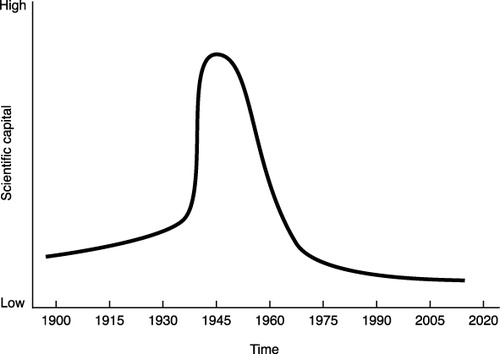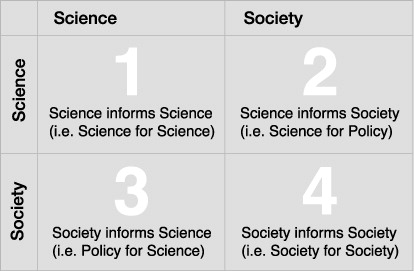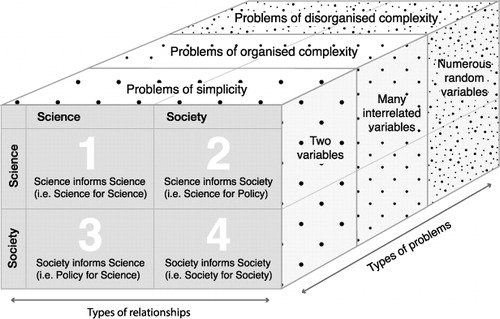Abstract
Sir Paul Callaghan, physicist and founding director of the MacDiarmid Institute for Advanced Materials and Nanotechnology, believed that science can provide many answers about the world we live in, but cannot tell us how to live. In this statement he highlights the relationship between science and society: while science is concerned with enquiry and scepticism—‘is this true?’—society is concerned with values and beliefs—‘is this right?’. Einstein viewed science as a powerful instrument, a knife that could be used for good or for ill, emphasising that science can be both a benefit and a risk to society. The future of science is likely to be shaped by how well we create connections and build relationships between science and society, rather than focusing on the differences and therefore the boundaries that separate science from society. This paper argues that scientific thought is not just the domain of scientists but of society and its representatives as well. Scientific thought is defined as ‘what we don’t know but want to know’. To understand the role of scientific thought, it is necessary to understand the relationships between scientific thought, scientific capital, scientific activity and scientific knowledge. This paper argues that if scientific thought sets the direction, scientific capital is the propellant—the energy force that produces scientific activity. Scientific capital can be defined as the extent to which society supports science over time. Lastly, with a little luck, scientific activity leads to scientific knowledge. How this knowledge is collected, reported, stored and accessed will determine the direction of scientific thought going forward. This paper concludes by proposing a framework for assessing the relationship between science and society so that we might improve the quality of scientific thought in the future.
The context
In his 1934 book, The logic of scientific discovery, Karl Popper explored the question: ‘what is science?’ However, it was not until the 1960s that the history of science began to develop as a discipline in its own right. In 1962, physicist T.S. Kuhn wrote The structure of scientific revolutions, suggesting that scientific knowledge was not linear and that occasionally a new revolution in knowledge will occur that creates a new paradigm and wave of research (Trombley Citation2012, pp. 256–261). However, neither of these books explores deeply the role of society as a driver of scientific thought and scientific capital; rather their focus is on scientific activity and scientific knowledge. Many academics, however, acknowledge this relationship. American professors Gorovitz and MacIntyre note in their 1975 paper that ignorance is a precondition for scientific activity: ‘Should everything be known about a given area of science, all scientific activity would cease, even though work might continue on the practical application of that knowledge’ (Gorovitz & MacIntyre Citation1975).
To help explain this relationship, it is worth going back to the Second World War. President Franklin D. Roosevelt commissioned a report by Vannevar Bush, the director of the US Office of Scientific Research and Development (OSRD). Roosevelt's objective was to seek recommendations on government policies for combating disease, supporting research, developing scientific talent and diffusing scientific information. In July 1945, Science, the endless frontier was published. Bush's report called for a centralised approach to government-sponsored science, leading to the establishment of the National Science Foundation and a significant increase in government funding (Pielke Citation2010). The report acknowledged the idea of scientific capital. Bush noted that science does not operate in a vacuum, ‘But is conditioned by the political system that controls its operations and applications … [science] depends upon what is desired by authority, by those who rule or represent the people’ (Bush Citation1949, p. 5). The war had not only provided an opportunity to galvanise scientific thought, it had also delivered scientists prestige and academic freedom through their contribution to the war effort.
This increase in scientific capital was felt not only in America. In the UK, Sir Edward Bullard, a marine geophysicist for the Royal Naval Mine and Torpedo School at Plymouth, put it this way: ‘[A] professor of physics might be more sinister than he was in the 1930s, but he was no longer an old fool with a beard in a comic-strip’ (Hamblyn Citation2011, p. 366). Bullard’s reflections are contained in a 1974 Royal Society lecture on the effects of war on scientific research:
The important lessons for post-war science were how to use the government's machine, how to get one's way with committees, how to persuade people with arguments suitable for their backgrounds and prejudices and how realistically to assess the means needed for a given end … I suspect that the most important effect of World War II on physical science lay in the change of attitude of people to science. The politicians and the public were convinced science was useful and were in no position to argue the details.
However, he goes on to acknowledge that, by 1974, this scientific capital had decreased significantly:
Today the impetus is largely spent, the expansion has levelled off and the weathercock of public opinion has swung around. There is now a real danger that, because certain problems have been neglected, the public will believe they are insoluble by scientific means and that we must settle down to cultivate our garden and leave most of the world to starve, freeze or blow itself up. (Hamblyn Citation2011, pp. 365–366)
Although Bullard does not explain how the scientific capital was ‘spent’, it may have something to do with the way science was managed over that time. Secret nuclear testing, radioactive fallout, stockpiling of nuclear weapons and poor regulation of pesticide use are perhaps some of the reasons why the relationship between science and society became problematic. Linda Lear, a biographer and historian, reflected in the afterword of a 2000 reprint of Rachael Carson's 1962 book Silent spring:
Carson did more than challenge the scientific establishment, or force the implementation of new pesticide regulations. The hostile reaction from the establishment to Carson and her book was evidence that many government and industry officials recognised that Carson had not only challenged the conclusions of scientists … [but] had undermined their moral integrity and leadership. She had toppled America's blind faith in science and, more damaging still, she initiated public debate over the direction of technological progress. (Carson Citation2000, p. 259)
Arguably, the Second World War was a catalyst to grow scientific capital whereas more recently the debate over the cause of anthropogenic climate change may erode this capital. Society's commitment to science waxes and wanes over time. If scientific capital is low, is this society failing to develop clarity and consensus over the future direction of scientific thought? illustrates what the waxing and waning of scientific capital might look like if we were able to benchmark trends over time.
The science/society framework
In order to resolve society's most pressing problems, it is vital to explore how we can improve the direction of scientific thought and gain support for scientific capital. The second part of this paper puts forward a framework to not only chart the current relationship between science and society but to explore the ways we might generate more clarity over scientific thought, and increase support for more scientific capital, in the longer term.
The proposed framework for improving the quality of scientific thought over time aims to not only improve the quality of relationships that exist between science and society but build tacit knowledge about the types of problems those relationships might face going forward.
divides the types of relationships that can exist between science and society into four quadrants. Each quadrant is likely to have different stakeholders, who in turn will have their own goals, skills, resources, information gaps, institutional relationships and policy instruments.
Quadrant one aims to support scientific endeavour in the science community largely through effective scientific activity and accessible knowledge. There are numerous policy knots within this sphere: we think of policy knots as issues that are easy to identify but are difficult to unravel and therefore resolve (McGuinness et al. Citation2012, pp. 93–113).
Quadrant two aims to embed science into public policy so that society is sufficiently informed to contribute to scientific thought and activity through the provision of capital.Footnote 1 The importance of this idea was further reinforced by the New Zealand National Science Challenges Panel 2013 report. It recommended that a special ‘science and society’ challenge be added, as it ‘Sees this special challenge as of the highest priority and central to giving optimal effect to the twelve scientific challenges proposed’ (NSCP Citation2013). This led to the launch of a ‘national strategic plan for science in society’ in 2014 (MSI Citation2014).
Quadrant three aims to optimise investment in science but is often at risk of reverting to a funding ethos. The distinction between an investment model and a funding model is extremely important; investment requires a stakeholder's approach – what does society want?Footnote 2
Quadrant four aims to create an informed society. This goes back to Callaghan's and Einstein's ideas mentioned at the beginning of this paper. Both eminent scientists recognised the importance of values and beliefs as a way of ‘society shaping society’ and saw science simply as a tool to be used well.
It would be interesting to analyse each quadrant in more detail, but New Zealand possibly has a tendency to focus on quadrants one and two at the expense of three and four.
Analysing the context in terms of the four quadrants (above) is useful, but it does not tell us about the types of problems each quadrant is facing. This is where the idea developed by Dr Warren Weaver, the past director for the Division of Natural Sciences of The Rockefeller Foundation, becomes extremely useful. See an illustration of his continuum in .
Before retiring, Weaver wrote his reflections on a quarter century in the natural sciences. The timing of this was important. He had spent the past 25 years designing and implementing the foundation’s new programme on all living things. Before the 1930s, the focus was predominantly on medicine and health. This change in direction was significant as the foundation began considering how best it might contribute to society and that man was part of the system.
Weaver described the seventeenth, eighteenth and nineteenth centuries as the period in which physical science learned how to analyse two-variable problems. These are problems where ‘the behaviour of the first quantity can be described with a useful degree of accuracy by taking into account only its dependence upon the second quantity, and by neglecting the minor influence of other factors’ (Weaver Citation1958, p. 8). He concluded that physical science before 1900 was largely concerned with two-variable ‘problems of simplicity’.
Subsequent to 1900, there was a move to assess problems that consisted of a large number of variables, leading mathematicians to devise probability theory and what Weaver called problems of ‘disorganised complexity’. Weaver used billiards as a way of explaining this new approach. Imagine:
[A] large billiard table with millions of balls flying about on its surface, colliding with one another and with the side rails. The great surprise is that the problem now becomes easier: the methods of statistical mechanics are now applicable. One cannot trace the detailed history of one special ball, to be sure; but there can be answered with useful precision: on the average how many balls per second hit a given stretch of rail? On the average how far does a ball move before it is hit by some other ball? On the average how many impacts per second does a ball experience? (Weaver Citation1958, p. 11)
Weaver goes on to describe a great middle region that had remained relatively untouched by science and yet was critical for the future of humankind. He referred to this group of problems as those of organised complexity:
But much more important than the mere number of variables is the fact that these variables are all interrelated … They are all problems which involve dealing simultaneously with a sizeable number of factors which are interrelated into an organic whole. (Weaver Citation1958, pp. 13–14)
This idea of organised complexity has had a resurgence; Jane Jacobs’ book The death and life of great American cities (1961), which applies Weaver's idea to cities, has been quoted heavily by the UK chief scientific adviser, Sir Mark Walport, at the launch of the future of cities project (Walport Citation2013).
Weaver's continuum is arguably a lot more useful than Rittel & Webber’s (Citation1973) idea of tame or wicked problems, whereby they posited that social scientists’ problems were more difficult to resolve than those of pure scientists and engineers. They noted: ‘Science has developed to deal with tame problems’ and ‘The kinds of problems that planners deal with—societal problems—are inherently different from the problems that scientists and perhaps some classes of engineers deal with. Planning problems are inherently wicked’ (pp. 155, 160). The idea that some problems are simply too complex to solve in the short term has not been helpful for those trying to find ways to solve them.
Putting Weaver's continuum together with the quadrants forms the framework illustrated in .
How one solves a problem of organised complexity is an urgent area of study. Using climate change as an example,Footnote 3 we can tease out the relationships necessary to solve the problem. A good starting point would be to explore similar types of problems to learn more about how they were created and how they were resolved (or not resolved). Revisiting the climate change example, it is not enough for scientists to form a view (quadrant one), for science to inform society (quadrant two) or for society to invest in science (quadrant three). There also needs to be a concerted effort to become an informed society (quadrant four). For the McGuinness Institute, this has meant undertaking a number of public policy workshops with young people aged 18–25,Footnote 4 immersing them in public policy that is characterised by organised complexity that they are unable to gain from textbooks and lectures.
What is clear is that we all have work to do. If we do not, society might believe problems of organised complexity (such as climate change, cancer, hunger and obesity) are unsolvable, in which case, as Bullard provokingly suggested in his 1974 lecture, developed nations might decide ‘to cultivate our garden and leave most of the world to starve, freeze or blow itself up’ (Hamblyn Citation2011, p. 366).
Notes
1. Arguably, the recent disestablishment of the European Union’s chief scientific officer position raises concerns over how best to embed science advisers in government (Bawden Citation2014).
2. See criticism contained in a recent McGuinness Institute submission on the MSI Draft National Statement of Science Investment (McGuinness Citation2014).
3. ‘No single option is sufficient by itself.’ (IPCC Citation2014, p. 2)
References
- Bawden T 2014. Researchers attack Brussels for ousting top scientific adviser professor Anne Glover. The Independent, 14 November. http://www.independent.co.uk/news/science/researchers-attack-brussels-for-ousting-top-scientific-adviser-professor-anne-glover-9862272.html ( accessed 5 December 2014).
- Bush V 1949. Modern arms and free men. New York, Simon and Schuster. 274 p.
- Carson R 2000. Silent spring. London, Penguin Group. 323 p.
- Gorovitz S, MacIntyre A 1975. Toward a theory of medical fallibility. Hastings Center Report 5: 13–23.
- Hamblyn R 2011. The art of science: a natural history of ideas. New York, Picador. 484 p.
- International Panel on Climate Change 2014. Climate change 2014: synthesis report. Geneva, Intergovernmental Panel on Climate Change (IPCC).
- McGuinness W 2014. Submission: Draft National Statement of Science Investment (NSSI) 2014–2024 – Draft for Consultation. Wellington, McGuinness Institute. 27 p.
- McGuinness W, Hickson R, White D 2012. Report 9: science embraced: government-funded science under the microscope. Wellington, Sustainable Future Institute. 184 p.
- MSI 2014. Science in society project. Wellington, Minister of Science and Innovation. http://www.msi.govt.nz/update-me/major-projects/science-and-society-project ( accessed 15 December 2014).
- National Sciences Challenges Panel 2013. Report of National Science Challenges Panel, March 27. Wellington, Office of the Prime Minister's Chief Science Advisor. 46 p. http://www.pmcsa.org.nz/wp-content/uploads/Report-of-National-Science-Challenges.pdf ( accessed 3 February 2015).
- Pielke R Jr. 2010. In retrospect: science—the endless frontier. Nature 466: 922–923.10.1038/466922a
- Rittel HWJ, Webber MM 1973. Dilemmas in a general theory of planning. Policy Sciences 4: 155–169.10.1007/BF01405730
- Trombley S 2012. Fifty thinkers who shaped the modern world. London, Atlantic Books. 402 p.
- Walport M 2013. Speech by Sir Mark Walport at the Foundation for Science and Technology conference on cities of the future [Transcript]. London, Government Office for Science. https://www.gov.uk/government/speeches/future-of-cities-launch ( accessed 16 June 2014).
- Weaver W 1958. A quarter century of natural sciences. In: The Rockefeller Foundation ed. The Rockefeller Foundation annual report, 1958. New York, The Rockefeller Foundation. Pp. 1–124.



